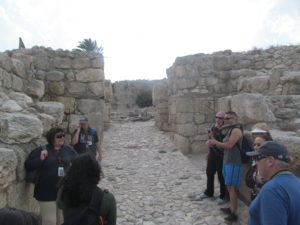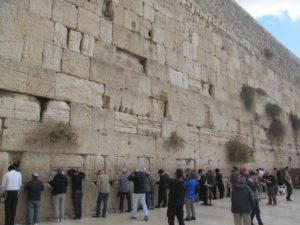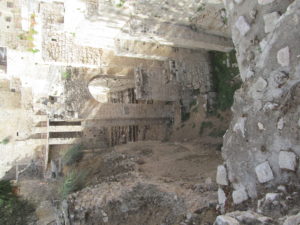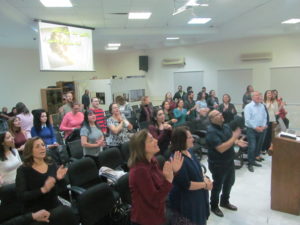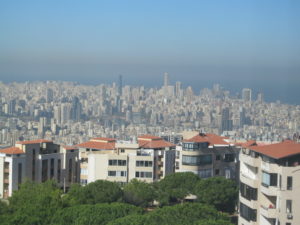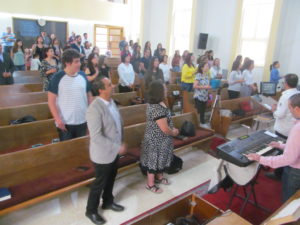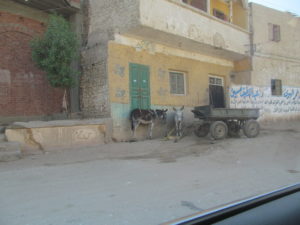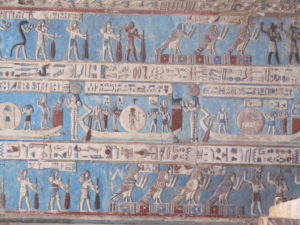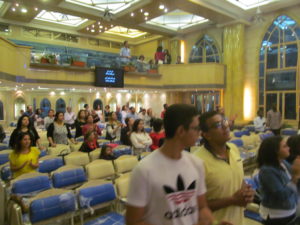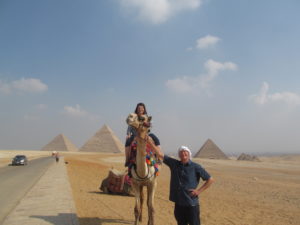Missionary Teaching trip to Israel, Jordan, Lebanon and Egypt: Journal
We are now on our way home from Egypt. This is the final addition to the journal
Middle East Fall, 2018 Journal
October 22-28 Israel
Jan and I are here in Israel as part of Doug Jacoby’s Biblical Study Tour for a seven day sojourn through Israel. We arrive at Tel Aviv on Monday at 3:25 AM. The first day we visit Jaffa, the port city from which Tel Aviv grew. Tel Aviv is second city of Israel. It is quite cosmopolitan and it wears its Jewishness relatively lightly. We head on Tuesday up the coast to Caesarea Maratima, the city and port built by Herod the Great. This is where Paul spent more than two years in prison and where the Pilate Inscription was discovered which proved the skeptics about the crucifixion with regard to Pilate to be wrong. From there we drove up the coast and headed inland to Mt. Carmel to visit a Druze village and to contemplate the scene when Elijah stared down 450 prophets of Baal, winning a great victory for Jehovah. From there we traveled to Magdala where we got to view a synagogue from the first century. This is the home town of Mary of Magadala. It is only about four miles from Capernaum. It is certain that Jesus taught in this synagogue. We completed our first day of travel with a cruise on the Sea of Galilee.
On the Sea of Galilee with the Bittencourts.
Day two included a drive north to Caesarea Philippi which is in the Golan Heights. This is the scene where Peter replied to Jesus that He is the Messiah—the Son of the living God. We saw the “gate of Hades” that will not prevail that Jesus mentioned, which is the gate of the idol Pan. From there we traveled to the ancient city of Dan or Laish. The city has massive fortifications. It also includes the infamous altar set up by Jeroboam where the bull idols were set up. These are the idolatrous images which Jereboam told his people were their gods. That is a sad story. We were awestruck to see the gate to the city of Canaanite city of Laish from the nineteenth century. This is almost certainly the gate that Abraham came up to as he pursued Kerdolaomer to get back the things taken from Lot. A tithe of the spoils of this campaign were given to Melchizedek.
At the 19th century BC Laish Gate
But we were not done with the day yet. From there we traveled south go visit the city of Kepher Nanum, which to us is Capernaum. This was the center of activity of Jesus’ ministry on Galilee. Here Peter had his house. There is a remnant of a church which goes back to the third or fourth century on the likely site of Peter’s house. The restored ruins of the city, including a fourth century synagogue are quite impressive.
On Thursday we traveled in a generally southerly direction. First, we visited Nazareth, the place where Jesus was raised. It was prophesied that the Messiah would come as the shoot of a branch, and Nazareth means branch. We visited a reconstruction of the city of Nazareth and saw a winepress and watchtower from the first century. From there we traveled to Tell Megiddo, which is the scene of so many great conflicts in biblical history. It is where Sisera was killed and where Deborah helped to defeat his army. This is where Solomon built one of his great fortified cities and where Josiah was killed in a battle. The tell (hill) is made of twenty-five identifiable layers of building from well before 2000 BC to the Persian period. We came out of the tell through the water tunnel, built through solid rock to the spring at the bottom of the hill. This was very impressive.
Solomon’s Gate, Megiddo
From there we traveled east toward the Jordan to the city of Beth She’an, which was the capitol of the Decapolis and is at the end of the Jezreel valley. There is a massive Graeco-Roman city here. There is a beautifully preserved theater here which can hold around 10,000 spectators. Saul and Jonathan died in battle at Beth She’an. Jesus passed through this city as he passed down to Jericho on his way to Jerusalem. From there we drove down the Jordan valley, through Jericho and up to Jerusalem.
During the tour we are able to spend time with some of our best friends such as the Cox’ from London, the Bittencourts from Sao Paulo and many more. This is a great fellowship opportunity.
Jerusalem is the chief city of Israel. It is in the Judean Hills above the Dead Sea. It is divided into Palestinian and Israeli territory. This city is the holy city of Judaism as well as one of three holy cities for Islam and the cradle of the Christian Church. There are many mosques, churches and Synagogues here. The population is nearly 30% conservative Jews, which has a dramatic effect on the culture and the politics. This is a beautiful and inspiring city. Here is the Temple Mount with the Muslim Dome of the Rock and the Al Aksa Mosque, as well as the Wailing Wall—so important to the Jews and the Church of the Holy Sepulcher at the supposed site of the burial of Jesus. There are so many holy sites here it is hard to keep track of them.
On Friday we take a walking tour of the city. We enter through the Damascus Gate, passing to the Western Wall. We tour the underground excavations at the base of the Temple Mount.
The stones in the supporting wall are massive. It is here that men and women pray at separate parts of the wall. From there we visit the site of the Praetorium where Jesus was put on trial before Pilate and was scourged. We follow the traditional Via Dolorosa (Latin for way of suffering) to the West of the city where Jesus is supposed to have been killed. On the way we stop at the beautiful Church of St. Anne, built by Crusaders in the twelfth century as well as the Pool of Bethsaida—a two level set of pools with five colonnades where Jesus healed the Paralytic on the Sabbath. The excavations here are quite recent and are truly spectacular. From there we pass through the Jewish Quarter, out of the city walls to Gallicantu. This is now a church but it is the likely site of the High Priest Caiaphus’ house where Jesus was put on trial before the Sanhedrin. We visit a dungeon which is a likely site where Jesus was held pending his trial. This has been a very full day, but we also spend some time at the beautiful Jaffa Gate. Before sundown the city grinds to a halt as this is Shabbat (Sabbath).
On Saturday the city feels almost deserted. We travel down the Jerusalem/Jericho road which Jesus used as the setting for the Parable of the Good Samaritan. We spend some time in Jericho, the site of what may well be the oldest city in the world, with settlement for over eleven thousand years. Of course, this is near where the Jews crossed the Jordan and began the conquest of the Promised Land. From Jericho we travel south to Qumran. This is a fascinating archaeological site as it is the greatest center of the Essene sect of Judaism in the first century BC and AD. There are many mikvahs here as the sect made at last twice-daily washings. This is where the Dead Sea Scrolls were copied that were found above the settlement in caves. The Qumran monastery was abandoned in AD 68, at which times thousands of scrolls were hidden in caves, only to be discovered after 1947, telling us much about Judaism at that time, and also providing strong support for the reliability of the Old Testament.
On the way back to Jerusalem we stop for a swim in the Dead Sea. The water is so salty that perhaps 30% of one’s body is above the water. This is a bizarre feeling, but it is fun to experience.
Sunday was a very special day. We began with a visit to the City of David, which is on a prominence on the North of the Temple Mount. We descended to the bottom of the wall to the Spring of Gihon. This was the water source of the city from the time of the Canaanites and the Jebusites, all the way back to 1500 BC. 2 Chronicles 32:1-5, 30 records how Hezekiah closed off
the source of the water and had a tunnel built through solid rock from within the city to the Spring of Gihon. We walked through this tunnel, which is more that 1700 feet long. It is an amazing feat of engineering that crews working from both sides were able to meet at the middle. The tunnel still carries water from the spring into the city. At the end of the spring we visited the Pool of Siloam, which is where the healing of the man born blind, in John 9, was performed. We really get a sense of Jesus ministry as we stride the side of this very large pool.
From there we explored the Southern end of the Temple Mount, going up to the Huldah Gate, which was the main entrance to the Temple Mount. This gate was named after the prophetess Huldah (2 Chronicles 34:22-28). From there we went to the Mount of Olives and the Garden of Gethsemane for a worship service and prayer. Our final visit to the Old City included spending time in the Church of the Holy Sepulcher, which is the traditional site of the crucifixion and the burial site of Jesus. The church was built in the fourth century and may very well occupy the site of the burial of Jesus. Unfortunately, it is now the site of much bickering among Catholics, Orthodox, Syrians and Copts over territory in this site, which has become a kind of idolatrous place of worship for many. This ended our wonderful tour of Israel. Many thanks to Doug Jacoby and Steve Kinnard and others for putting on this visit to the Holy Land.
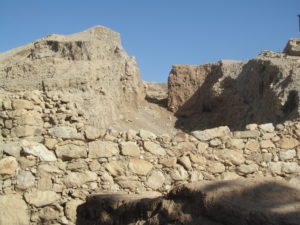
Walls of ancient Jericho
Amman, Jordan October 30-Nov 3
The trip to Amman is not an easy one. Due to recent restrictions, the normal crossing point to Jordan, the Allenby Gate, is closed to us, so Jan and I had to travel two hours north, almost all the way back up to Galilee to cross near Beth She’an. On the way, we paid a brief visit to the ancient city of Jericho, which was the first city conquered by God’s people after they crossed the Jordan. This is one of the most ancient city in the world, with signs of urban life more than ten thousand years old.
When we crossed into Jordan we are met by Simon Hinn and his wife Rima. They returned recently from leading our sister church in Cairo for several years. Simon was converted in San Diego all the way back in 1982. When he returned to Jordan in 1984, he found himself alone in a Muslim country. Rather than renounce his faith or compromise his convictions, he started his own Bible group and converted most of his family and a number of friends. When a team came to plant a church in Amman in 1990 they found a group of ten already meeting and worshipping together. What an amazing example of faithfulness! The leader of the group here is Sami Sakakini. He was one of the first converts here in Jordan. He spent some time leading a young church in Iraq where he was arrested and spent 3-1/2 months in an Iraqi prison before being expelled from the country. Leading a church in the Muslim Middle East is risky business.
Amman is a beautiful city of nearly three million in the country Jordan which has about ten million. This is a solidly Muslim country, governed by the Arab Hashemite kings. Although there is little political freedom here, King Hussein and his son Abdullah have created a stable and relatively prosperous state in the volatile Middle East. Arabs from throughout the Middle East come here to shop and vacation because it is a great melting pot and is stable and safe. Jordan has received more than one and a half million refugees from Iraq and Syria. To give this context, if the US were to receive the same proportion of refugees, it would mean more than 50 million new residents entering our country. This is a generous and welcoming people. Their hospitality is legendary.
Church in Amman
This is exemplified by the church here. We meet Simon as well as Sami and his wife Fadia take us to a very fancy restaurant, serving the wonderful local food. The lamb and chicken here are amazing, and the local pita bread and, of course, hummus are delicious. In the evening we meet at Sami and Fadia’s house with the leaders of the singles group and the campus and teen group.
On Tuesday we visit the ancient citadel of Amman. This was the capital of the ancient Ammonites, who were the first people defeated by Israel before the crossed the Jordan. It has been occupied since at least 5000 BC. 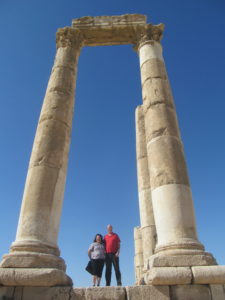 We also spend time in the Roman-era amphitheater, which is one of the best preserved in the world. We had an interesting interaction. As we drank coffee with Simon and Rema a woman came up to us and said “haram” to Jan, which means shame, as she pointed to Jan’s uncovered shins and feet. In the evening I teach a class on “Answering the Hard Question” such as the trinity, which is a particularly difficult point in sharing with Muslims and the question of suffering and warfare in the Old Testament. The church here is particularly interested in being prepared to answer criticism of Christianity coming from Islam. The church here has eighty members. There are sixty at the meeting, including several guests. This meeting was principally for the singles and campus group. A pastor of two Baptist churches in Amman is in attendance. We find that his doctrine is more like what the church here teaches than mainstream Baptists. We are really encouraged by this.
We also spend time in the Roman-era amphitheater, which is one of the best preserved in the world. We had an interesting interaction. As we drank coffee with Simon and Rema a woman came up to us and said “haram” to Jan, which means shame, as she pointed to Jan’s uncovered shins and feet. In the evening I teach a class on “Answering the Hard Question” such as the trinity, which is a particularly difficult point in sharing with Muslims and the question of suffering and warfare in the Old Testament. The church here is particularly interested in being prepared to answer criticism of Christianity coming from Islam. The church here has eighty members. There are sixty at the meeting, including several guests. This meeting was principally for the singles and campus group. A pastor of two Baptist churches in Amman is in attendance. We find that his doctrine is more like what the church here teaches than mainstream Baptists. We are really encouraged by this.
At the Citadel of Amman
Sami tells us he went to Iraq with his family several years ago to help lead the church there. After a short time he was arrested and spent three and a half years in prison under terrible conditions. He thought he might be killed at any time. The entire time his wife and very young children did not even know if he was alive. Two other Iraqi brothers spent three years in prison. None of them were ever charged. This willingness to suffer for Christ is a great challenge to Jan and I.
Wednesday is a more restful day. The class in the evening is on Freedom in Christ and the use of our gifts as ministers in the church. On Thursday we travel to Jerash. This is an ancient city Gerasa of the Ammonites. It was the largest city of the Decapolis of the Romans. This is the largest and most well-preserved Roman city we have seen. Driving there, we pass through Palestinian refugee camps. We learn that the border with Syria was opened just a couple of weeks ago after being closed for seven years due to the civil war. Hope is dawning for peace and that the refugees may be able to begin returning to their homes. The evening is a third lesson for the church here on the Existence of God. It is surprising to us that in this very religious country atheism is beginning to find a place to the point that the members of the church need to be prepared to answer questions from non-believers.
Beirut, Lebanon Nov. 2-5
The flight from Amman to Beirut is only an hour. The last time I came this way we had to fly down to Egypt and over the Mediterranean because of war in Syria, but now Syria is sufficiently peaceful we can fly over Syrian airspace. Beirut is one of the most beautiful cities is the world, sitting at the side of the Mediterranean, set among mountains. Because of the mountains, this is a very green country. It is the only one in the Middle East with no deserts. Lebanon went through twenty-five years of civil war between the Sunni and Shia Muslims as well as the large Maronite Christian group here, with Syria and Iran constantly meddling in the country. The politics here are very complicated with the many groups. The Christian party allies itself with the Shia Hezbollah group which is why there is such deep enmity with Israel. Let’s just say it is complicated.
Beautiful Beirut
On the other hand, Lebanon is the most democratic country in the region with the most open attitude toward ideas and relatively liberal attitudes toward religious freedom. This is a small country of only five million people. It is shocking to learn that nearly half the population is refugees from Syria. Just try to imagine two hundred and fifty million refugees coming into the US or seventy million refugees coming into the UK. The impact of the people and the economy is massive, of course.
We are met by Moufid Thome. He and his wife Jesse lead this church of about eighty. This is a very young church, with many teens, campus and young singles. On Friday evening I give a lesson, The Bible, From God or Man? There are about eighty in attendance, including at least twenty visitors. The questions are very lively. Afterward, we go out for a late dinner of Lebanese food. The food here is absolutely fantastic. It is legendary. It is also very healthy. Moufid and Jesse moved about a year ago with their two children to lead the church in Cairo. After a few months Moufid was deported. Jesse and the children stayed behind for five months. Moufid got very sick in Egypt, nearly dying from heart troubles for which there was not good health care there. This was a very turbulent time for their family. Such is the way in the Middle East.
On Saturday we spend time with Allah and Daniella, a young couple who are leading the teen group. Both were raised in very turbulent situations. Allah is Syrian by birth, although he came to Lebanon as a very young child twenty-four years ago to escape a violent father who had converted to radical Islam. He is treated as a person without a country, which makes it impossible for him to travel and very difficult to get a job. In the evening I teach at Middle East University on the Christian worldview with about sixty in attendance, including a professor, a pastor and many other guests.
Sunday is a great day here. I give a class on evidence for Jesus. There are about ninety in church, with many guests, including a few Muslims. Some of them are now studying the Bible. After, we travel about 25 miles north to the ancient city of Byblos. This city has been settled for more than 5,000 years. It has beautiful ruins which have been converted into a place to have dinner by the sea or to shop. We visit a church of John Mark from about the fifth century. The construction is amazing. From there we travel back to Beirut for a two and one-half session of questions and answers. This was an “optional” meeting, yet more than two-thirds of the church is there, despite having three prior meetings in the last three days. The desire to learn here is truly inspiring. Monday was spent with Moufid and Jesse visiting Beirut and dreaming of ways to help build up the church here and make inroads into the Muslim Middle East. This is a difficult task, but it is a necessary one.
Church in Beirut
Luxor and Cairo, Egypt Nov 6-12
We travel next to Egypt, where we will be teaching in Cairo. First, because part of this trip is a celebration of our 35th anniversary, we are spending three days visiting Luxor in upper Egypt. This is the area with the greatest concentration of ancient Egyptian sites. Wednesday we visit the Valley of the Kings, which is the burial place of the kings from the 18th through the 20th dynasties (about 1600-1200 BC). One of these is the Pharaoh of the Exodus, although no one is certain which. The decoration of the tombs is spectacular.
Donkeys in the countryside
We also visited the temple of Queen Hatshepsut, as well as the massive temples of Karnak and Luxor. The columns and engravings are like nothing else in the world. The color of the painting is still vivid after three thousand five hundred years. Thursday we visit temples in Abydos and Dendera, from the eighteenth dynasty and from the Ptolemaic periods. We drive for several hours through the countryside, seeing amazing scenes of everyday life. The people here are generally very poor. They still use donkeys to bring their produce to market. They are so friendly, as the children wave to us in greeting, saying welcome wherever we go.
Dendera Temple ceiling drawings
On Friday we traveled back to Cairo. This is a massive city of just over twenty million. It is the largest city in Africa. This is a very crowded city. The traffic is legendary. Actually, it is not legendary because everything they say about it is true! This is a Muslim country, of course, but there is actually a fairly large minority—around 15%–of Coptic Christians here which has been tolerated despite 1300 years of Muslim rule. The politics of the country have been tumultuous. First there was the Arab Spring in 2011, which brought on a revolution that ousted the dictator/president. Then, two years later there was a second revolution which ousted the democratically elected Morsi from the Muslim Brotherhood. The two intervening years brought on a lot of persecution for Christians. Now a new dictator Al Sisi is in power and things seem to be stabilizing, although the economy is in bad shape. The people are really suffering here. Yet, they are so gracious and always have a smile, especially for guests.
Church in Cairo
The church we are visiting has about seventy members. They have gone through a fair amount of turbulence lately, with leadership changes and with the political and religious turmoil here in Egypt. Maged and Nissa Tadros lead the group, but there is no full time leadership since Moufid and Jesse Tohme were deported earlier this year. Not having legal status is also a difficulty. There is a lot of need here for a mature couple to consider coming here for an extended stay in order to stabilize the church. The members are so welcoming and warm it is really something. Will one of you reading this journal will consider coming here to help with issues such as parenting, marriage as well as basic Bible teaching? Please pray about this.
On Friday I spoke on Galatians: Living by Law or by the Spirit. In this very religious country the tendency is to look for rules and requirements and to rely on the leaders to do the work of the ministry. The church is very receptive to this message. Worship here is on Friday, not Sunday, as this is the closest thing to a Sabbath in this Muslim country and Sunday is a normal day of work. This is very different for us, but it makes sense given the culture.
At the Cheops Pyramids
On Saturday Jan and I get to visit the Pyramids of Giza with Wagdy and his wife Shiren. This is one of those bucket list moments. In the evening I was able to teach the teens and campus on God and Science. It is hard to explain how encouraging to see twenty young people who are so eager to learn about God. The questions could have gone on for many hours. We are so blessed to be able to encourage the faith of the youth in Egypt. Almost everyone we talk to here see the future of the church in the youth. They have asked for a campus or single person to come here to take the one year challenge to help the church. The need is still out there. Please consider coming here to help build a foundation for Christ in this wonderful country. It will change your life forever.
Sunday Jan gave a class at the home of Abeer and Ramez for the women on having a heart for God based on the cross of Christ. Despite the fact that this is a workday, over half the women in the church come to the lesson. We get to experience real Egyptian home cooking which is wonderful, including Alexandrian style fava beans and a dish of feta cheese, tomato and green pepper, and, as always, Egyptian bread. We leave Egypt on Monday, exhausted but encouraged so much to be able to meet so many devoted disciples of Jesus from the most ancient culture in the world.
John Oakes
11/12/18



